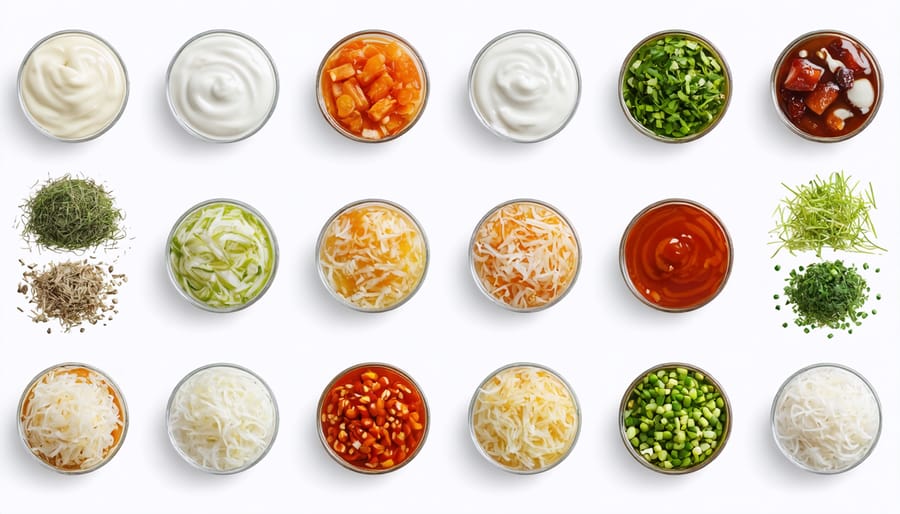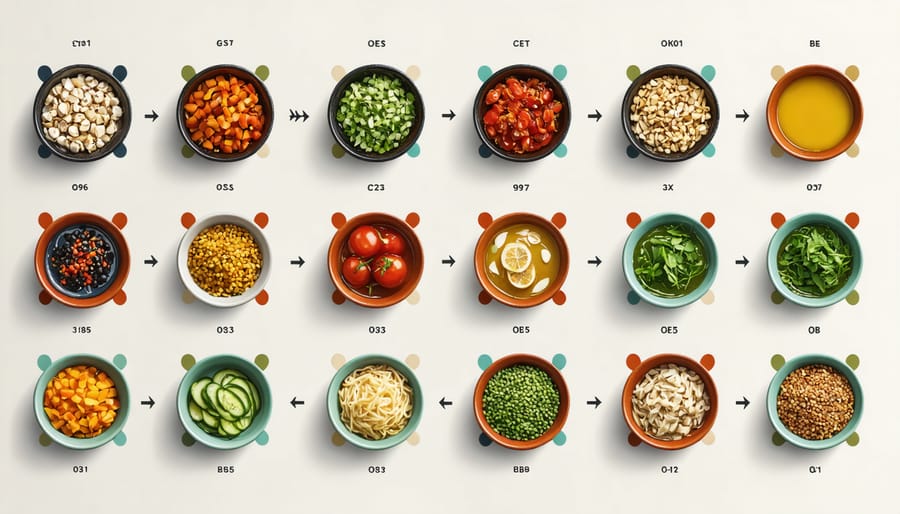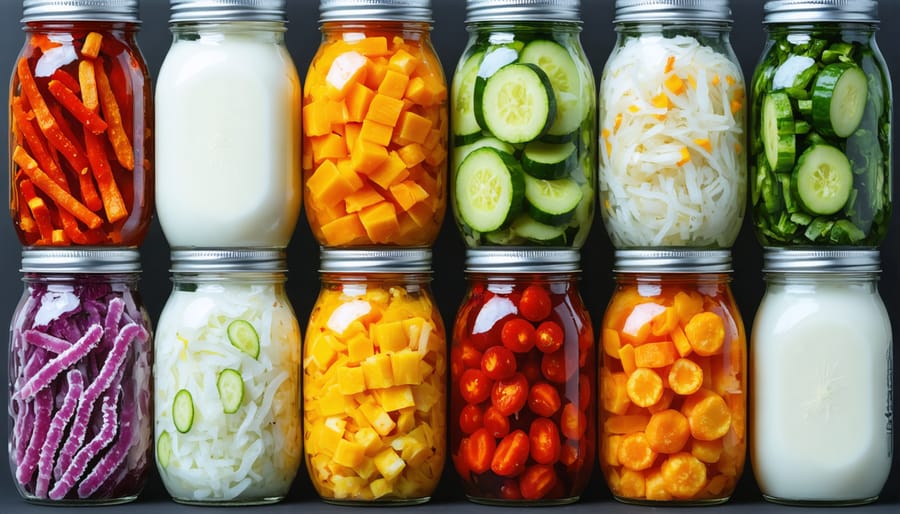Lactobacillus bacteria transform ordinary foods into probiotic powerhouses through fermentation, a process that humans have relied on for thousands of years. These remarkable microorganisms convert sugars into lactic acid, creating the distinctive tangy flavors in foods like yogurt, sauerkraut, and kimchi while naturally preserving them. Beyond preservation, lactobacillus fermentation enhances food’s nutritional value by increasing vitamin levels, producing beneficial compounds, and creating easily digestible forms of proteins and carbohydrates.
Today, as more Canadians seek natural ways to support their gut health and immune system, understanding lactobacillus fermentation becomes increasingly valuable. These beneficial bacteria not only create delicious foods but also contribute to a healthy microbiome, improved digestion, and enhanced nutrient absorption. Whether you’re interested in the science of fermentation or looking to incorporate more fermented foods into your diet, understanding how lactobacillus works can help you make informed choices about your health and nutrition.
What Makes Lactobacillus Your Gut’s Best Friend
The Science Behind These Helpful Bacteria
Lactobacillus bacteria work their fermentation magic through a fascinating natural process. These beneficial microorganisms convert sugars and carbohydrates into lactic acid, creating an environment that preserves food while developing distinctive flavors and textures. As part of your gut microbiome, lactobacillus species help maintain digestive health by producing essential nutrients and compounds that support immune function.
During fermentation, these bacteria break down complex molecules into simpler, often more digestible forms. This process naturally increases the nutritional value of foods while creating antimicrobial compounds that help prevent the growth of harmful bacteria. The acidic environment produced during fermentation also acts as a natural preservative, extending the shelf life of foods without artificial additives.
What makes lactobacillus particularly special is their ability to thrive in different food environments, from dairy products to vegetables, creating diverse fermented foods that have been enjoyed across cultures for centuries.

Key Health Benefits for Canadians
Lactobacillus fermentation offers several key health benefits that are particularly relevant for Canadians. These beneficial bacteria help strengthen our immune system, potentially reducing the risk of common winter illnesses that frequently affect our population. Regular consumption of fermented foods can improve digestive health by maintaining a balanced gut microbiome, which is especially important given our increasingly processed modern diet.
Research suggests that fermented foods containing lactobacillus may help reduce inflammation and support mental health – crucial benefits during our long winter months when seasonal mood changes are common. For Canadians managing lactose intolerance, which affects about 7-10% of our population, fermented dairy products can be easier to digest than regular dairy.
Additionally, these beneficial bacteria may help absorb nutrients more effectively from our food, supporting overall health and potentially boosting immunity during our challenging cold seasons. They also contribute to maintaining healthy cholesterol levels, an important factor for cardiovascular health in our aging population.

Popular Foods Transformed by Lactobacillus
Yogurt and Kefir
Yogurt and kefir are among the most popular dairy products that rely on lactobacillus fermentation. In these foods, lactobacillus bacteria convert milk sugar (lactose) into lactic acid, creating the distinctive tangy taste and thick texture we associate with fermented dairy. While both products use similar fermentation processes, they differ in their bacterial composition and health benefits.
Yogurt typically contains two main bacterial strains: Lactobacillus bulgaricus and Streptococcus thermophilus. These beneficial bacteria work together to ferment milk, producing a smooth, creamy texture. The process takes about 4-8 hours under controlled temperatures.
Kefir, on the other hand, contains a more diverse range of bacteria and beneficial yeasts. Traditional kefir is made using kefir grains, which are actually colonies of various microorganisms, including multiple strains of lactobacillus. The fermentation process for kefir usually takes 24 hours at room temperature, resulting in a slightly fizzy, tangy drink that’s more liquid than yogurt.
Both foods offer excellent sources of probiotics, protein, and calcium, making them valuable additions to a healthy diet. They’re particularly beneficial for digestive health and immune system function.
Sauerkraut and Kimchi
Sauerkraut and kimchi are two of the most popular fermented vegetables worldwide, both created through the natural action of Lactobacillus bacteria. In sauerkraut, shredded cabbage is combined with salt, creating an environment where beneficial Lactobacillus species thrive and convert natural sugars into lactic acid. This process not only preserves the cabbage but also creates the distinctive tangy flavor that makes sauerkraut a beloved condiment.
Similarly, kimchi, a traditional Korean dish, relies on Lactobacillus fermentation to transform napa cabbage, radishes, and other vegetables into a complex, spicy fermented food. The process typically takes several days to weeks, during which the beneficial bacteria multiply and produce compounds that contribute to kimchi’s characteristic taste and aroma.
Both foods are excellent sources of probiotics and offer numerous health benefits, including improved digestion and enhanced immune function. When making these fermented vegetables at home, maintaining proper salt levels and ensuring vegetables remain submerged in their brine is crucial for successful fermentation. Store-bought versions should specify “raw” or “unpasteurized” to ensure live beneficial bacteria are present.
Other Fermented Favorites
Beyond kimchi and sauerkraut, lactobacillus plays a key role in creating many other beloved fermented foods. Tempeh, a protein-rich Indonesian staple made from fermented soybeans, offers a meaty texture perfect for plant-based meals. Miso, another soybean-based ferment, adds rich umami flavor to soups and marinades. Traditional sourdough bread relies on lactobacillus working alongside wild yeasts to create its distinctive tangy taste and improved digestibility. Various fermented beverages like kefir and lassi provide probiotic benefits in a drinkable form. Pickled vegetables, from classic dill pickles to pickled carrots and beets, also get their tangy flavor and preservation from lactobacillus fermentation. These diverse options make it easy to incorporate fermented foods into your daily meals.
Adding Fermented Foods to Your Daily Diet
Simple Ways to Start
Starting your fermentation journey doesn’t have to be complicated. Begin by incorporating store-bought fermented foods like plain yogurt, kefir, or kombucha into your daily meals. These readily available options are perfect for beginners and contain beneficial lactobacillus bacteria.
For those ready to try home fermentation, sauerkraut is an excellent first project. Simply shred cabbage, add salt, and pack it tightly in a clean jar. Let it ferment at room temperature for 3-7 days, checking daily. The natural lactobacillus present on the cabbage leaves will do the work for you.
Another easy option is making your own pickles. Combine cucumbers with salt water, garlic, and dill in a jar. Within a week, you’ll have probiotic-rich pickles. Start small with single-jar batches until you’re comfortable with the process.
Remember to introduce fermented foods gradually into your diet, starting with small portions. A tablespoon of sauerkraut with meals or a few ounces of kefir in your morning smoothie is a great way to begin. As your body adjusts, you can slowly increase portions and experiment with different fermented foods.

Shopping and Storage Tips
When shopping for fermented foods, look for products stored in the refrigerated section of your grocery store. Check for clear, uncompromised packaging and ensure the “best before” date hasn’t passed. Quality fermented products should have a clean, pleasantly sour smell and appear free from unusual discoloration or mold.
For homemade ferments, always use clean, sterilized glass jars with tight-fitting lids. Store your fermented foods in the refrigerator after the initial fermentation period to slow down the process and maintain optimal flavor. Most fermented vegetables can last 4-6 months when properly refrigerated, while dairy-based ferments typically keep for 1-2 months.
Keep fermented products away from direct sunlight and maintain a consistent cool temperature. If you notice any unusual smells, excessive pressure buildup in containers, or visible mold (except the white film common in some ferments like kombucha), it’s best to discard the product.
For optimal probiotic benefits, consume fermented foods regularly and avoid heating them, as high temperatures can destroy beneficial bacteria.
Safety and Considerations
While fermented foods containing lactobacillus are generally safe for most people, it’s important to follow proper food safety guidelines during preparation and consumption. When fermenting at home, always use clean equipment, fresh ingredients, and appropriate salt concentrations to prevent harmful bacteria growth. Watch for signs of spoilage such as unusual colors, off-putting odors, or mold (except in specific cases like blue cheese where certain molds are intentional).
Some individuals may experience temporary digestive symptoms like bloating or gas when first introducing fermented foods into their diet. Start with small portions and gradually increase intake to allow your digestive system to adjust. People with compromised immune systems, pregnant women, and those with specific health conditions should consult their healthcare provider before consuming homemade fermented foods.
Store-bought fermented products should be kept refrigerated and consumed before their expiration date. Check that packaging is intact and properly sealed. For home fermentation, maintain appropriate temperature conditions and use proper storage containers designed for fermentation.
If you’re new to fermenting, consider starting with simple recipes and reliable sources of information. Monitor your ferments regularly and trust your senses – if something doesn’t look, smell, or taste right, it’s better to err on the side of caution and discard it.
For those taking probiotics or medications, be aware that fermented foods can interact with certain treatments. While rare, some people may have histamine sensitivities to fermented foods. If you experience unusual reactions, discontinue consumption and seek medical advice.
The role of lactobacillus in fermentation is both fascinating and beneficial for our overall health. These remarkable bacteria transform everyday foods into nutrient-rich, probiotic-packed options that can support digestive health, boost immune function, and even contribute to better mental well-being. By incorporating fermented foods like yogurt, kefir, sauerkraut, and kimchi into your daily diet, you can harness these health benefits while enjoying delicious, tangy flavours.
Start small by adding a serving of fermented food to one meal per day. You might try yogurt with breakfast, kimchi with lunch, or a small portion of sauerkraut with dinner. Remember that homemade fermented foods can be a rewarding and cost-effective option, though store-bought versions offer similar benefits for those with busy schedules.
As research continues to reveal the importance of gut health for overall wellness, including fermented foods in your diet becomes increasingly valuable. Whether you’re looking to improve digestion, strengthen your immune system, or simply expand your culinary horizons, lactobacillus-fermented foods offer a natural, time-tested way to support your health goals.

